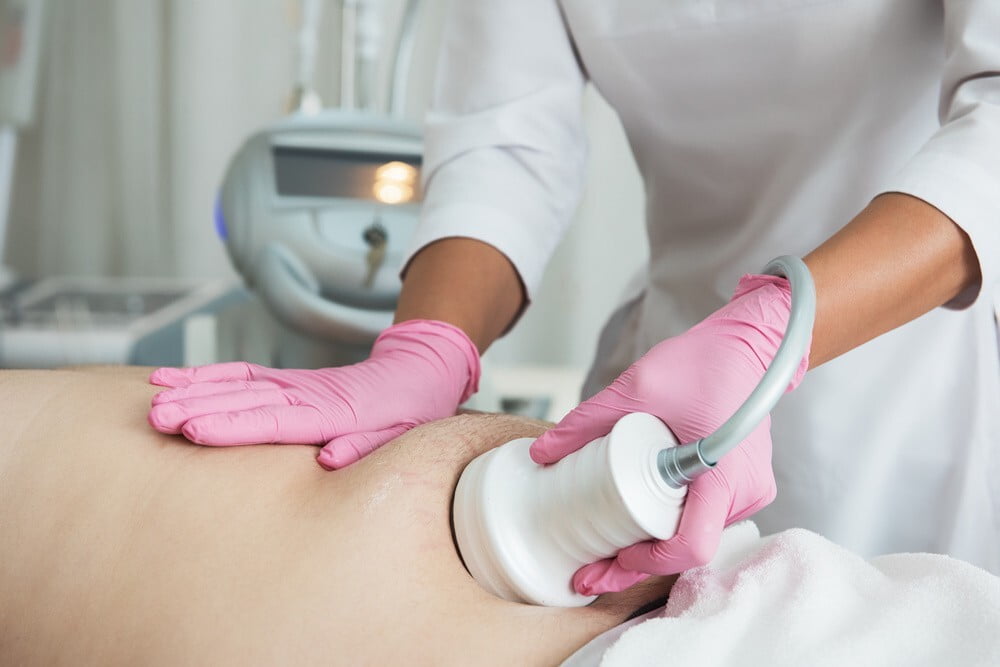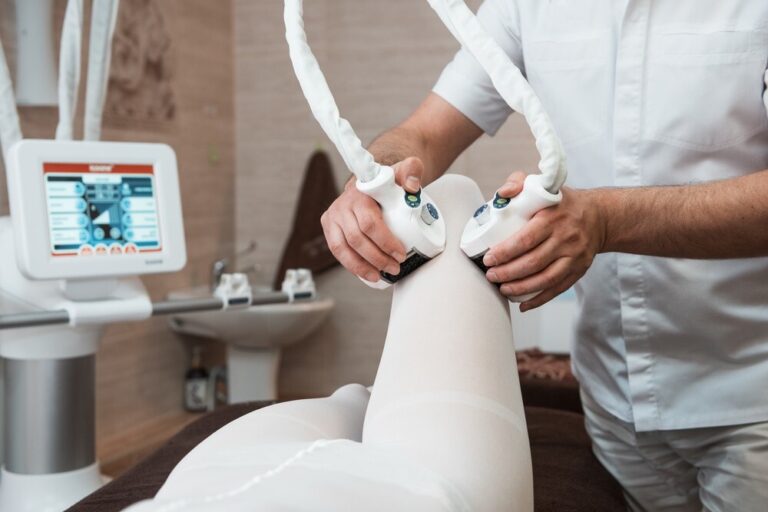Ultrasonic Cavitation – Is Cosmetic Treatment Harmful?
Are you afraid of being harmed when undergoing ultrasonic cavitation? Well, then you might be surprised to find out that the procedure is both safe and effective.
Ultrasonic cavitation is a non-invasive cosmetic treatment used for skin tightening and reduction of cellulite.
It is a cosmetic procedure of fat removal and cellulite reduction. Ultrasonic cavitation devices produce pulsating ultrasonic waves that cause mechanical vibration in the targeted skin area.
The vibration breaks the adipose tissue, which has tiny micro-bubbles that implode to break up the fat and release fatty acids in the body. This process stimulates collagen production, which theoretically makes the skin tighter.
It is a treatment used in beauty salons and wellness centres to reduce cellulite and eliminate fat deposits.
It is an alternative to liposuction and uses high-frequency sound waves to break up free fatty acids deposits under the skin.
Ultrasonic cavitation does not destroy fat cells but liquefies them so that you can naturally eliminate them over time as you lose weight.
What are the side effects?
Ultrasonic cavitation has many benefits and little to no side effects. The most common side effect is a skin irritation that results from the high-frequency vibration of the skin caused by ultrasonic cavitation.

In addition, some people report pores appearing more significant, minor cuts on the skin, or flu-like symptoms after using ultrasonic cavitation machines.
However, these effects are infrequent, and some dermatologists claim they are never reported in clinical studies of ultrasonic cavitation treatments. It also causes redness and swelling, referred to as a “cavitation bump”.
What are the benefits?
The benefits of this procedure include a decrease of fat and cellulite after each treatment and may also improve skin tone.
Ultrasonic cavitation has been used to treat cellulite, acne scars, stretch marks, and wrinkles. It makes use of ultrasound waves technology that has been used in hospitals for many years to treat a variety of ailments.
Is it an effective procedure?
These high-intensity ultrasonic energy devices are one of the newest techniques used to reduce fat and cellulite.
The procedure does not yet have clinical studies that prove its effectiveness. However, it has been widely used in beauty spas and wellness centres for over ten years, so it is likely relatively safe.
How long do the results last?
The effects of ultrasonic cavitation last around six months after each treatment but can vary from person to person. However, some people experience longer-lasting results (one year or more).
However, it is known that the effects fade over some time. Therefore, the reduction of fat cells after each treatment will lessen as time progresses.
Does it destroy fat cells?
Ultrasonic cavitation is a form of liposuction that does not destroy the fat cells. Imagine a deflated balloon filled with water- when the air is released, the water will come out, but the balloon remains.
It is similar to how ultrasonic cavitation works- it liquefies fat by releasing fatty acids in your body. As you lose weight, your body will naturally remove the remaining fat cells over time.
Is Ultrasonic cavitation safe?
Ultrasonic cavitation has been used for several years in beauty spas and wellness centres. It has also been used in the medical field for surgical, aesthetic, and therapeutic purposes.
Ultrasonic cavitation has few side effects, although many are self-limiting and can be easily managed by the patient.
Therefore, ultrasonic cavitation is probably safe but has not been tested enough to determine its safety in the long term.
How much does ultrasonic cavitation cost?
Ultrasonic cavitation is a relatively new technology, so prices vary greatly as well. Therefore, it is best to contact a clinic or beauty spa near you for an accurate estimate of the cost of ultrasonic cavitation treatments.
Is there any alternative therapy?
There are no alternative therapies that can help with cellulite. However, some exercises and diets may help reduce the appearance of cellulite, such as eating a healthy diet, combining cardio and strength training, and drinking plenty of water.
Is there any way to make the procedure less painful?
Ultrasonic cavitation machines are designed so that it is still able to remove fat and stimulate collagen production effectively.
However, some people may experience pain after each treatment due to the pulsating vibration of the machine.
It is similar to how a surgical tool causes pain after cutting through the skin; however, it should not be severe enough to cause lasting damage or discomfort.
Is it just another form of liposuction?
Ultrasonic cavitation uses high-intensity ultrasound energy waves to break down fat cells under the skin.
It does not remove or suck up fat the way liposuction does but instead causes it to come out of the body naturally by stimulating collagen production.
Who can opt for ultrasonic cavitation?
Ultrasonic cavitation is a safe and effective procedure that can be used on any part of the body. Ultrasound technology is used to treat various skin conditions such as acne, cellulite, wrinkles, stretch marks, and scarring.
However, ultrasonic cavitation is not commonly used because it does not destroy fat cells like liposuction.
Therefore, it is only recommended for people who have very noticeable fat deposits or those with very little fat to lose.
People with a lot of weight, particularly those with cellulite or loose skin, want to reduce or eliminate fat cells to give a more youthful look and feel.
Ultrasonic cavitation can be used alone or combined with liposuction to make the procedure more effective and efficient.
There is no specific time limit for ultrasonic cavitation. However, after several treatments, it may take a few months before you start noticing changes.
People with medical conditions or who are elderly may experience more extended recovery periods from ultrasonic cavitation.
Two types of cavitation machines exist - continuous-wave and pulsating. The latter is designed to be more intense but can also cause more pain.
A phlebogel is also used to decrease pain in the treatment area and reduce bruising from compression of the blood vessels during the procedure.
Is it harmful?
Ultrasonic cavitation is a relatively new technique, so there are no clinical studies that confirm its safety. However, this treatment has been used in beauty spas and wellness centres for over ten years without severe side effects.

Ultrasonic cavitation does cause skin irritation and swelling after each treatment. However, these effects can be easily managed by the patient.
Like any form of liposuction, ultrasonic cavitation is not recommended for people who have had recent surgery or with medical conditions that involve increased body temperature.
In addition, ultrasound therapy may cause inflammation and swelling after each treatment. However, these side effects will diminish over time.
Can ultrasound cavitation be reversed?
The effects of ultrasonic cavitation are temporary. As with any liposuction, the fat cells will shrink and be gradually removed from the body over time. However, it is unlikely that you will see drastic results after just one or two ultrasonic treatments.
Ultrasonic cavitation will give you improved skin tone and elasticity. However, this will not eliminate cellulite or improve the skin on your entire body.
Is there any damage to the surrounding tissue or skin?
Ultrasonic cavitation increases blood flow to the treated part and can cause slight redness and a slightly swollen feeling in the treated area. The area may also feel sore for several days after each treatment.
Does ultrasonic cavitation hurt?
Any form of liposuction can cause discomfort under the skin. However, ultrasonic cavitation has a higher vibration rate which makes the procedure more intense.
Therefore, it makes it more likely that you will experience some pain during and after each treatment.
Final thoughts
Although it is possible to reduce or remove fat from the body with this technique, this may not be desired by all people.
Ultrasonic cavitation may help reduce pain after liposuction and reduce recovery periods, but other means of weight reduction are available.
It is not a weight-loss treatment option; ultrasonic cavitation is more popular as a treatment for cellulite. It is because it is not as aggressive as liposuction and requires far less recovery time.
Accompany the procedure with a low-calorie diet and regular physical exercise. If you cannot exercise heavily, try using an aerobic machine that can be used at home.
So to answer the question – Is ultrasonic cavitation harmful?
This procedure has been used for over ten years in beauty spas and wellness centres without severe side effects. So with this, we can say that ultrasonic cavitation is safe and effective.
I hope this article answers your questions about ultrasonic cavitation. Make sure that you focus on remaining healthy during your weight loss program to keep the fat from returning in the future.
Stay safe and healthy!




